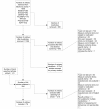Suitability of measures of self-reported medication adherence for routine clinical use: a systematic review
- PMID: 22050830
- PMCID: PMC3219622
- DOI: 10.1186/1471-2288-11-149
Suitability of measures of self-reported medication adherence for routine clinical use: a systematic review
Abstract
Background: There is a recognised need to build primary care medication adherence services which are tailored to patients' needs. Continuous quality improvement of such services requires a regular working method of measuring adherence in order to monitor effectiveness. Self report has been considered the method of choice for clinical use; it is cheap, relatively unobtrusive and able to distinguish between intentional and unintentional non-adherence, which have different underlying causes and therefore require different interventions. A self report adherence measure used in routine clinical practice would ideally be brief, acceptable to patients, valid, reliable, have the ability to distinguish between different types of non-adherence and be able to be completed by or in conjunction with carers where necessary.
Methods: We systematically reviewed the literature in order to identify self report adherence measures currently available which are suitable for primary care and evaluate the extent to which they met the criteria described above. We searched the databases Medline, Embase, International Pharmaceutical Abstracts, Pharmline, CINAHL, PsycINFO and HaPI to identify studies reporting the development, validation or reliability of generic adherence measures. One reviewer screened all abstracts and assessed all relevant full text articles obtained and a second reviewer screened/assessed 10% to check reliability.
Results: Fifty eight measures were identified. While validation data were presented in support of the vast majority of self reported measures (54/58), data for a relatively small number of measures was presented for reliability (16/58) and time to complete (3/58). Few were designed to have the ability to be completed by or in conjunction with carers and few were able to distinguish between different types of non-adherence, which limited their ability be used effectively in the continuous improvement of targeted adherence enhancing interventions. The data available suggested that patients find it easier to estimate general adherence than to report a specific number of doses missed. Visual analogue scales can be easier for patients than other types of scale but are not suitable for telephone administration.
Conclusions: There is a need for a measure which can be used in the routine continual quality monitoring of adherence services.
Figures
References
-
- Department of Health. Pharmacy in England. Building on strengths-delivering the future. London: The Stationary Office; 2008.
-
- Haynes RB, Ackloo E, Sahota N, McDonald HP, Yao X. Interventions for enhancing medication adherence. London: Cochrane Database of Systematic Reviews; 2008. - PubMed
-
- Trueman P, Taylor DG, Lowson K, Blighe A, Meszaros A, Wright D, Glanville J, Newbould J, Bury M, Barber N, Jani YH. Evaluation of the Scale, Causes and Costs of Waste Medicines. York: University of York; 2010.
Publication types
MeSH terms
LinkOut - more resources
Full Text Sources
Medical
Miscellaneous


